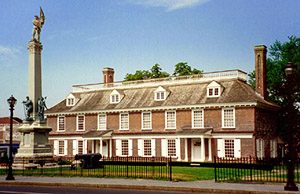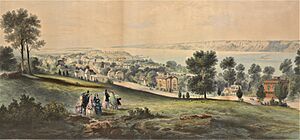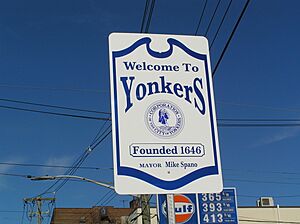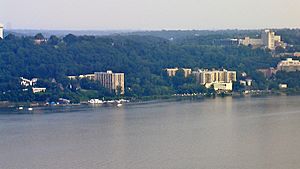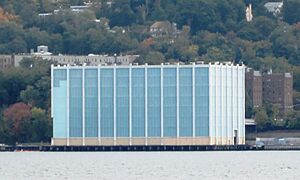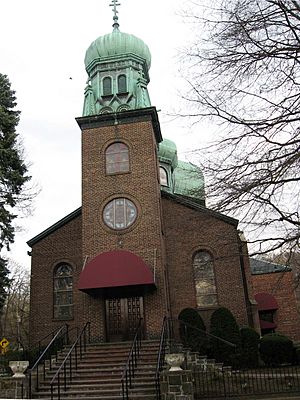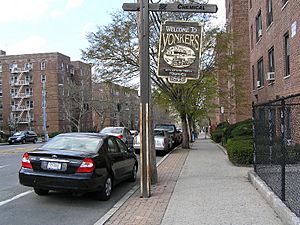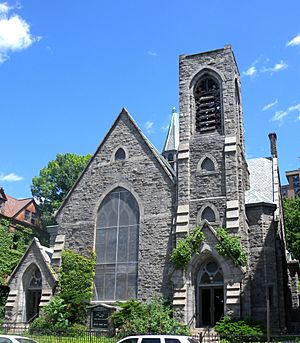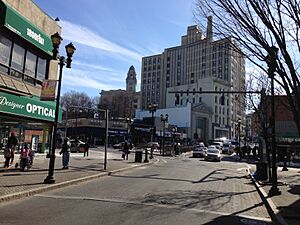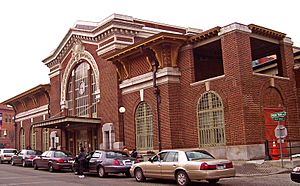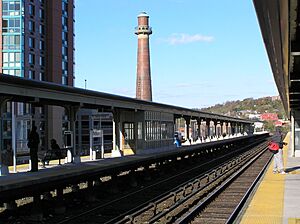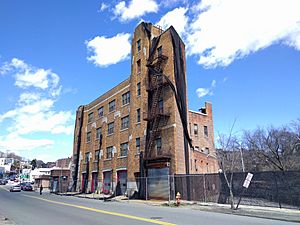Yonkers, New York facts for kids
Quick facts for kids
Yonkers
|
|||
|---|---|---|---|
| Corporation of the City of Yonkers | |||
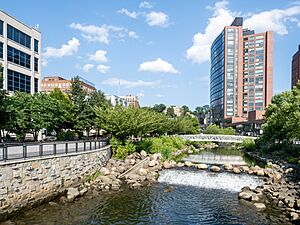
The daylighted Saw Mill River at Getty Square (2023)
|
|||
|
|||
| Nicknames:
The Central City, The City of Gracious Living, The City of Seven Hills, The City with Vision, The Sixth Borough, The Terrace City
|
|||
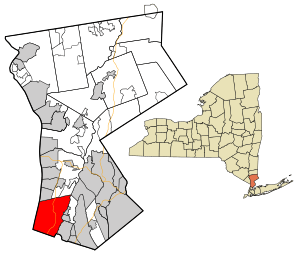
Location of Yonkers in Westchester County, New York
|
|||
| Country | United States | ||
| State | New York | ||
| County | Westchester | ||
| Founded | 1646 (village) | ||
| Incorporated | 1872 (city) | ||
| Government | |||
| • Type | Strong mayor–council | ||
| • Body | Yonkers City Council | ||
| Area | |||
| • Total | 20.27 sq mi (52.49 km2) | ||
| • Land | 18.01 sq mi (46.63 km2) | ||
| • Water | 2.26 sq mi (5.85 km2) | ||
| Elevation | 82 ft (25 m) | ||
| Population
(2020)
|
|||
| • Total | 211,569 | ||
| • Rank | US: 107th NY: 3rd | ||
| • Density | 11,749.92/sq mi (4,536.75/km2) | ||
| Demonym(s) | Yonkersonian Yonkersite Yonker Yonk |
||
| Time zone | UTC−5 (EST) | ||
| • Summer (DST) | UTC−4 (EDT) | ||
| ZIP Codes |
10701, 10702 (post office), 10703–10705, 10707 (shared with Tuckahoe, NY), 10708 (shared with Bronxville, NY), 10710, 10583 (shared with Scarsdale, NY)
|
||
| Area code(s) | 914 | ||
| FIPS code | 36-84000 | ||
| GNIS feature ID | 0971828 | ||
Yonkers is the third-largest city in New York State. It is the biggest city in Westchester County. Yonkers is very close to New York City, just north of the Bronx. In 2020, about 211,569 people lived there.
The main part of Yonkers is called Getty Square. This is where the city government is located. It's also a busy place with shops and businesses. Other big shopping areas include the Cross County Shopping Center and the Ridge Hill Mall.
Yonkers has many fun places to visit. These include Tibbetts Brook Park, Untermyer Park and Gardens, and the Hudson River Museum. The city is also known as the City of Seven Hills: Park, Nodine, Ridge, Cross, Locust, Glen, and Church Hills.
Contents
What's in a Name?
The name "Yonkers" comes from a Dutch word, Jonkheer. This word means "young gentleman". The area was given to a man named Adriaen van der Donck in 1645. People called him Jonkheer, and over time, this became "Yonkers".
A Look Back: Yonkers History
Early Beginnings
Long ago, Native Americans lived near the Neperah stream, which is now the Saw Mill River. The land became part of a large Dutch land grant called Colen Donck.
Adriaen van der Donck built a sawmill here. Near his mill, the Philipse Manor Hall State Historic Site was built around 1682. This was a large house owned by a rich Dutch family, the Philipses. Later, during the American Revolution, the Philipse family supported England. Because of this, their land was taken and sold by American colonists.
City Growth and Changes
Yonkers started as a village in 1854 and became a city in 1872. In 1874, some southern parts of Yonkers became part of New York City. This is why some people call Yonkers the "sixth borough" of New York City.
In 1937, a large water tower in Nodine Hills fell down. It injured 12 people and caused flooding. A new tower was built and opened in 1939.
Yonkers During Wartime
- American Civil War: Many Yonkers residents joined the U.S. Army and Navy. About 254 people from Yonkers fought in the war, and 17 were killed. The city also formed "Home Guards" to protect against riots.
- World War I: Over 6,900 Yonkers residents served in the military. Sadly, 137 of them died. People at home helped too. The local American Red Cross chapter grew to over 15,000 members. They made clothes and medical supplies. Yonkers residents also donated a lot of money to support the war.
- World War II: Factories in Yonkers changed to make things for the war. For example, the Alexander Smith and Sons carpet factory made tents. After the war, many factory jobs were lost because of competition.
Industry and Innovation
Yonkers was once a farming town. It grew peaches, apples, and other crops to send to New York City. Water power helped create many factory jobs.
- Elevators: In 1853, Elisha Otis invented a safety elevator in Yonkers. His company, Otis Elevator Company, opened the world's first elevator factory here. The factory later became the Yonkers Public Library.
- Carpets: The Alexander Smith and Sons Carpet Company was huge. It had 45 buildings and over 4,000 workers. It was one of the world's top carpet makers.
- Sports and Science: Yonkers played a role in sports history. The first golf course in the United States, Saint Andrew's Golf Club, was founded here in 1888. Also, Bakelite, the first fully man-made plastic, was invented in Yonkers around 1907 by Leo Baekeland. In 1940, the first FM radio broadcast happened from a home in Yonkers.
- Modern Industry: Many factories closed after World War II. Yonkers became a place where people lived and traveled to work in other cities. However, new industries have come to Yonkers. For example, a Kawasaki plant opened in 1986, making train cars. In 2024, Kawasaki made its 5,000th railcar in Yonkers.
Working Towards Fairness
In the past, Yonkers faced challenges with housing and schools. A court case in 1980, United States v. Yonkers, found that the city had kept housing and schools separate for different groups of people.
A federal judge ruled that Yonkers needed to change its policies. This led to a big discussion in the city. The city council eventually agreed to build more diverse housing. This was a difficult time, but it helped Yonkers work towards being a more fair and inclusive place for everyone. The story of this time was even made into a TV show called Show Me a Hero.
Yonkers Today
In the 2000s, more people from different backgrounds moved to Yonkers. Old factory buildings have been turned into art studios for the YoHo Artist Community.
Yonkers Raceway & Empire City Casino was updated in 2006 with video games. In 2018, MGM Resorts International bought it.
During the COVID-19 pandemic, Yonkers opened many testing sites to help people stay safe. In 2023, the US Post Office on Main Street became a local landmark. Also in 2023, Yonkers experienced flash flooding that caused a state of emergency.
Yonkers is a popular place for movies and TV shows. Films like Catch Me If You Can and Mona Lisa Smile were partly filmed here. The city is also the setting for the play Lost in Yonkers. A new Lionsgate Studios facility is growing in Yonkers, making it a big center for film and TV production.
Yonkers Geography
Yonkers covers about 20.3 square miles (52.49 km2). It borders Mount Vernon, Tuckahoe, Eastchester, Bronxville, and Scarsdale to the east. The Hudson River is its western border. Yonkers also touches parts of The Bronx to the south.
The city has many hills, rising from the Hudson River to 416 feet (127 m) above sea level. These are the "Seven Hills" of Yonkers. The Saw Mill River flows through Yonkers and into the Hudson River. Parts of this river, which were once hidden, have been uncovered. This helps local plants and animals, and teaches us about how Native Americans used the river long ago.
Who Lives in Yonkers?
| Historical population | |||
|---|---|---|---|
| Census | Pop. | %± | |
| 1860 | 8,218 | — | |
| 1870 | 12,733 | 54.9% | |
| 1880 | 18,892 | 48.4% | |
| 1890 | 32,033 | 69.6% | |
| 1900 | 47,931 | 49.6% | |
| 1910 | 79,803 | 66.5% | |
| 1920 | 100,176 | 25.5% | |
| 1930 | 134,646 | 34.4% | |
| 1940 | 142,598 | 5.9% | |
| 1950 | 152,798 | 7.2% | |
| 1960 | 190,634 | 24.8% | |
| 1970 | 204,297 | 7.2% | |
| 1980 | 195,351 | −4.4% | |
| 1990 | 188,082 | −3.7% | |
| 2000 | 196,086 | 4.3% | |
| 2010 | 195,976 | −0.1% | |
| 2020 | 211,569 | 8.0% | |
| Historical sources: 1790–1990 | |||
Yonkers is the third-largest city in New York State by population. Many different groups of people live here. In 2018, about 34.8 percent of residents spoke Spanish. Yonkers also has many people from the Middle East (like Jordanians and Palestinians) and Albania.
The city's population grew by eight percent from 2010 to 2020. The number of Hispanic and Latino residents increased to 40 percent. The Asian population also grew to 5.9 percent. This shows that Yonkers is a diverse and growing city.
| Historical racial profile | 2020 | 2010 | 1990 | 1970 | 1950 |
|---|---|---|---|---|---|
| White | 46.3% | 55.8% | 76.2% | 92.9% | 96.7% |
| —Non-Hispanic | 33% | 41.4% | 67.1% | 89.9% | N/A |
| Black or African American | 18.7% | 16.0% | 14.1% | 6.4% | 3.2% |
| Hispanic or Latino (of any race) | 40.0% | 34.7% | 16.7% | 3.5% | N/A |
| Asian | 5.9% | 5.8% | 3.0% | 0.4% | — |
2020 Census Details
| Race / Ethnicity (NH = Non-Hispanic) | Pop 2000 | Pop 2010 | Pop 2020 | % 2000 | % 2010 | % 2020 |
|---|---|---|---|---|---|---|
| White alone (NH) | 99,346 | 81,163 | 68,970 | 50.66% | 41.41% | 32.60% |
| Black or African American alone (NH) | 30,164 | 31,297 | 33,509 | 15.38% | 15.97% | 15.84% |
| Native American or Alaska Native alone (NH) | 362 | 382 | 330 | 0.18% | 0.19% | 0.16% |
| Asian alone (NH) | 9,290 | 11,370 | 12,915 | 4.74% | 5.80% | 6.10% |
| Pacific Islander alone (NH) | 53 | 58 | 34 | 0.03% | 0.03% | 0.02% |
| Other Race alone (NH) | 842 | 714 | 1,833 | 0.43% | 0.36% | 0.87% |
| Mixed race or Multiracial (NH) | 5,177 | 3,065 | 4,913 | 2.64% | 1.56% | 2.32% |
| Hispanic or Latino (any race) | 50,852 | 67,927 | 89,065 | 25.93% | 34.66% | 42.10% |
| Total | 196,086 | 195,976 | 211,569 | 100.00% | 100.00% | 100.00% |
Exploring Yonkers Neighborhoods

Yonkers has many unique neighborhoods, often grouped into four main areas. Each area has its own feel and history.
Northeast Yonkers
This area is home to many Irish-American and Italian-American families. Houses here range from small to large, especially in areas like Lawrence Park West. Central Avenue is a big shopping street.
Northeast Yonkers includes wealthy neighborhoods like Crestwood and Colonial Heights. You can find St. Vladimir's Seminary and Sarah Lawrence College here. The Ridge Hill Mall has a Legoland Discovery Center Westchester, which is a fun place for families. Many residents here work in Manhattan.
Northwest Yonkers
Northwest Yonkers stretches from the Hudson River to I-87. It has many beautiful Victorian-era homes with amazing views of the Palisades. Filmmakers often use these historic homes for movies.
People here care a lot about keeping old buildings safe. Important places include the Hudson River Museum and Untermyer Park and Gardens. A small shopping area known as "the north end" is also in this part of the city.
Southeast Yonkers
This area also has many Irish- and Italian-American residents. Its buildings look similar to parts of the Bronx. Eastern McLean Avenue is a lively area with an Irish community. A part of Midland Avenue in the Dunwoodie neighborhood is called "Little Italy."
Major landmarks include the Cross County Shopping Center and St. Joseph's Seminary. Both Pope John Paul II and Pope Benedict XVI have visited the seminary.
Southwest Yonkers
Getty Square is the heart of Yonkers, with its city center and main business area. This part of the city grew along old train and trolley lines. You'll find many apartment buildings, shops, and homes here.
Neighborhoods like Lowerre and Park Hill have a mix of building styles. Southwest Yonkers has welcomed many new residents from Mexico, Central America, the Caribbean, South Asia, and the Middle East. Some neighborhoods near the Riverdale border have a growing number of Orthodox Jewish families.
This area is home to historic sites like Philipse Manor Hall and the Science Barge. The Yonkers Public Library has a modern building here. The waterfront has been improved with new luxury apartments and restaurants.
Learning in Yonkers
Yonkers Public Schools runs the public schools in the city. There are also Catholic and Muslim schools. The Roman Catholic Archdiocese of New York manages the Catholic schools. The Academy for Jewish Religion, a school for rabbis and cantors, is in Getty Square.
Sarah Lawrence College is located in Yonkers. Westchester Community College also has centers in the city, including one at the Cross County Shopping Center. Saint Vladimir's Orthodox Theological Seminary is in Crestwood.
The Yonkers Public Library has three branches: Crestwood, Riverfront, and Grinton I. Will.
Getting Around Yonkers
Public Transportation
Many people in Yonkers use public transportation. About 27 percent of homes do not own a car. The Bee-Line Bus System provides bus service throughout Westchester County and into the Bronx. The Getty Square bus hub serves millions of passengers each year.
The Metro-North Railroad has two train lines that serve Yonkers: the Hudson Line and the Harlem Line. The Hudson Line has stations at Ludlow, Yonkers, Glenwood, and Greystone, offering rides to New York City. Amtrak trains also stop at the Yonkers station. Several Harlem Line stations are near the city's eastern border.
An old railroad line has been turned into the South County Trailway. This is a paved path for walking and biking. It runs through Yonkers and connects to Van Cortlandt Park in the Bronx. Yonkers also has an electric-scooter program.
Roads and Highways
Major highways in Yonkers include Interstate 87 (the New York State Thruway) and the Saw Mill, Bronx River, Sprain Brook, and Cross County Parkways. Important local roads include US 9, NY 9A, and NY 100.
Yonkers Fire Department
The Yonkers Fire Department (YFD) protects the city. It has 459 firefighters and operates from 14 fire stations. The department responds to about 16,000 emergency calls every year. They have many types of fire trucks, rescue vehicles, and even a fireboat.
Yonkers Economy
Yonkers is home to several brewing companies, like Simple Motive Brewing Company and Yonkers Brewing Company. The Yonkers Brewing Company opened in 2015 in an old trolley station.
During the COVID-19 pandemic, many people in Yonkers lost their jobs. The unemployment rate reached 19.4 percent in July 2020. However, by April 2023, the unemployment rate dropped to 2.8 percent, the lowest in the city's history.
Yonkers was where Otis Elevator Company started. Today, the Kawasaki Railcar Manufacturing plant, which makes train cars, is located in the former Otis factory.
Top Employers in Yonkers
Here are some of the largest employers in Yonkers:
- Montefiore IT – 780 employees
- Liberty Lines Transit – 689 employees
- Yonkers Raceway – 566 employees
- Stew Leonard's – 511 employees
- Kawasaki Rail – 455 employees
- Consumer Reports – 508 employees
- American Sugar Refining – 318 employees
- Macy's – 285 employees
- Cintas – 220 employees
Famous People from Yonkers
Sister Cities
Yonkers has special connections with cities in other countries:
 Ternopil, Ukraine (since 1991)
Ternopil, Ukraine (since 1991) Kamëz, Albania (since 2011)
Kamëz, Albania (since 2011)
See also
 In Spanish: Yonkers para niños
In Spanish: Yonkers para niños


